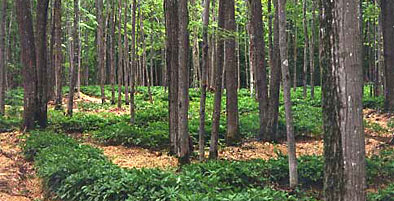“Agroforestry” is a broader term for a variety of different land-use practices of which “forest farming” is one. Agroforestry includes a broad group of practices that integrate trees with annual crops and/or livestock on the same unit of land for environmental and economic benefits. Agroforestry practices are designed to meet individual landowner needs. Forest farming is one of five formally recognized agroforestry “practices” in the United States.
Agroforestry has been defined in slightly different ways by different organizations and individuals. The USDA National Agroforestry Center (2012) states, “Agroforestry intentionally combines agriculture and forestry to create integrated and sustainable land-use systems. Agroforestry takes advantage of the interactive benefits from combining trees and shrubs with crops and/or livestock. Agroforestry practices include:
- Alley Cropping
- Forest Farming
- Riparian Forest and Upland Buffers
- Silvopasture
- Windbreaks”
Unlike forestry, agroforestry is not “tree farming,” or growing trees alone for timber or other products. Other annual crop or livestock components must be deliberately integrated in an intentional manner. Agroforestry is also not “wild harvesting,” or collecting wildly grown plants from a forest, because the harvester has not participated in the intentional management of the entire system.
Forest farming, unlike wild harvesting, involves the intentional management of both the overstory and understory components of the forest on a sustainable basis to produce non-timber forest products (NTFPs). Examples of NTFPs include medicinal herbs like ginseng (Panax quinquefolius), decorative plants like ferns, and food crops like mushrooms. Management techniques might include adjusting the light level on the forest floor by thinning or pruning trees, increasing plant populations by site preparation or seeding, or improving plant growth by weeding or thinning. Forest farming can provide income from NTFPs on a relatively short-term basis, while high-value timber is being produced over a longer term.
Reference
USDA National Agroforestry Center. 2012. “About Agroforestry.” www.unl.edu/
